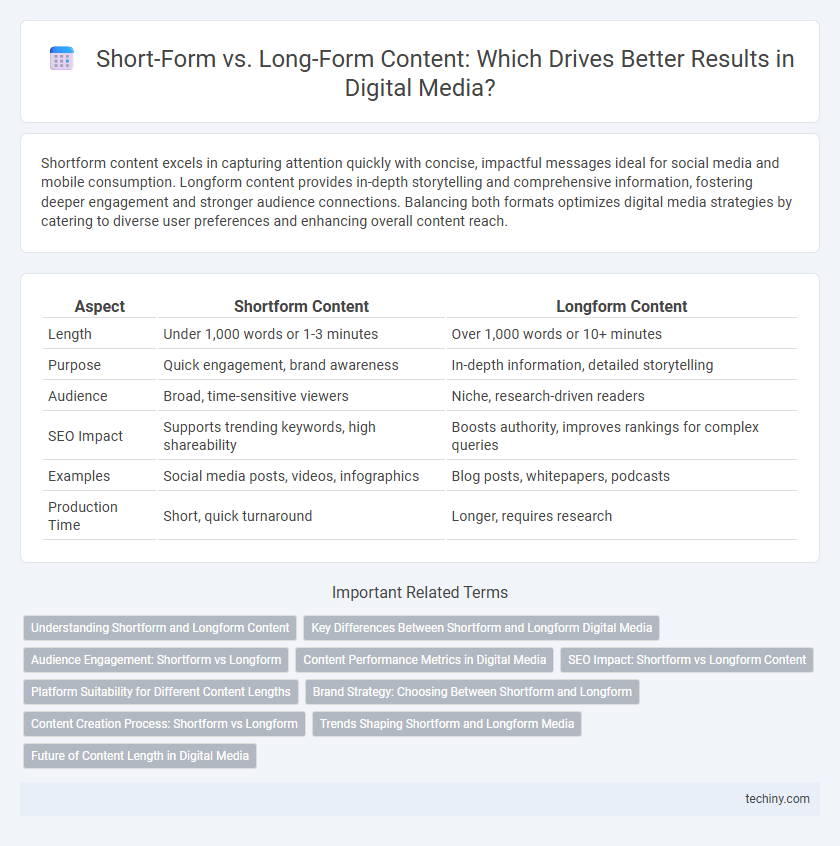Shortform content excels in capturing attention quickly with concise, impactful messages ideal for social media and mobile consumption. Longform content provides in-depth storytelling and comprehensive information, fostering deeper engagement and stronger audience connections. Balancing both formats optimizes digital media strategies by catering to diverse user preferences and enhancing overall content reach.
Table of Comparison
| Aspect | Shortform Content | Longform Content |
|---|---|---|
| Length | Under 1,000 words or 1-3 minutes | Over 1,000 words or 10+ minutes |
| Purpose | Quick engagement, brand awareness | In-depth information, detailed storytelling |
| Audience | Broad, time-sensitive viewers | Niche, research-driven readers |
| SEO Impact | Supports trending keywords, high shareability | Boosts authority, improves rankings for complex queries |
| Examples | Social media posts, videos, infographics | Blog posts, whitepapers, podcasts |
| Production Time | Short, quick turnaround | Longer, requires research |
Understanding Shortform and Longform Content
Shortform content typically ranges from a few seconds to a couple of minutes, designed to capture attention quickly and deliver concise, easily digestible messages ideal for social media platforms like TikTok and Instagram. Longform content, spanning several minutes to hours, offers in-depth exploration of topics, allowing for comprehensive storytelling and detailed information, commonly found in podcasts, documentaries, and extensive blog posts. Understanding the distinct purposes and audience engagement patterns of shortform and longform content helps digital media creators optimize their strategy for maximum impact and retention.
Key Differences Between Shortform and Longform Digital Media
Shortform digital media typically ranges from a few seconds to under five minutes, emphasizing quick consumption, high engagement, and shareability across platforms like TikTok, Instagram Reels, and YouTube Shorts. Longform digital media extends beyond ten minutes, offering in-depth information, detailed storytelling, and comprehensive analysis, commonly found in podcasts, webinars, and YouTube videos. Key differences include content depth, production time, audience retention strategies, and algorithmic prioritization on various digital channels.
Audience Engagement: Shortform vs Longform
Shortform content captures audience attention quickly with concise, impactful messages, driving higher engagement rates on fast-paced platforms like TikTok and Instagram. Longform content fosters deeper connection by providing detailed storytelling and comprehensive information, which boosts viewer retention and loyalty on platforms such as YouTube and podcasts. Audience engagement varies by format preference, with shortform excelling in immediacy and shareability while longform delivers sustained involvement and brand trust.
Content Performance Metrics in Digital Media
Shortform content drives higher engagement rates on social media platforms, with average view durations between 15 to 60 seconds boosting shareability and click-through rates by up to 40%. Longform content, typically exceeding 1,500 words or 10 minutes of video, excels in dwell time and SEO performance, increasing organic search traffic by 60% on average. Brands leveraging a balanced mix of shortform and longform content often see improved conversion rates, as shortform content attracts initial attention while longform content fosters deeper audience trust and retention.
SEO Impact: Shortform vs Longform Content
Shortform content typically drives higher engagement and faster indexing in search engines due to its concise, targeted nature, making it ideal for trending topics and social media platforms. Longform content enhances SEO by providing in-depth information, increasing dwell time, and generating backlinks, which improve site authority and rank for competitive keywords. Balancing shortform and longform content allows for optimized SEO strategies, catering to both quick user intent fulfillment and comprehensive topic coverage.
Platform Suitability for Different Content Lengths
Shortform content thrives on platforms like TikTok, Instagram Reels, and Twitter, where quick engagement and viral potential drive audience interaction. Longform content is better suited for YouTube, podcasts, and blogs, offering in-depth exploration and fostering stronger viewer retention and loyalty. Each platform's algorithm favors specific content lengths, making strategic alignment crucial for maximizing reach and impact in digital media campaigns.
Brand Strategy: Choosing Between Shortform and Longform
Shortform content drives rapid engagement and enhances brand visibility through concise, impactful messaging that captures the audience's attention within seconds. Longform content builds deeper brand authority by delivering comprehensive insights, fostering trust, and encouraging meaningful customer relationships. Brands must align content length with target audience preferences and marketing goals to maximize ROI and strengthen brand positioning.
Content Creation Process: Shortform vs Longform
Shortform content creation emphasizes speed, brevity, and high engagement, often requiring minimal scripting and rapid editing to capture immediate audience attention across platforms like TikTok and Instagram Reels. Longform content demands extensive research, detailed scripting, and thorough post-production, suitable for in-depth topics on YouTube or podcasts, facilitating deeper connection and comprehensive storytelling. Both approaches leverage unique production workflows optimized for their respective audience engagement goals and platform algorithms.
Trends Shaping Shortform and Longform Media
Shortform content thrives on platforms like TikTok and Instagram Reels, leveraging bite-sized, engaging formats that cater to decreasing attention spans and mobile consumption trends. Longform content, exemplified by podcasts and detailed YouTube videos, benefits from rising demand for in-depth storytelling, educational content, and brand authenticity. Emerging trends highlight AI-driven personalization and interactive features as key factors enhancing user engagement across both content types.
Future of Content Length in Digital Media
Shortform content dominates digital media by catering to shrinking attention spans and rapid consumption trends, driven by platforms like TikTok and Instagram Reels. Longform content remains valuable for in-depth storytelling, SEO benefits, and audience engagement on platforms such as YouTube and podcasts. The future of content length will likely involve a hybrid approach, leveraging AI-powered analytics to tailor content duration to user preferences and context, enhancing personalization and retention.
Shortform vs Longform Content Infographic

 techiny.com
techiny.com